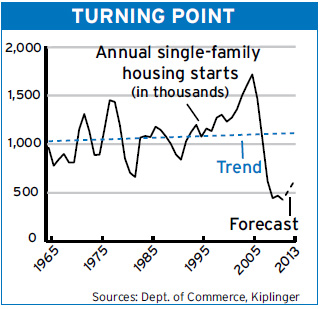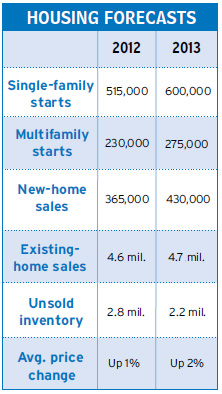3 Signs the Housing Recovery Has Arrived
Buyers are back, building is up -- and housing is poised to add to the economy instead of pulling it down.

Hallelujah. Housing is firmly on the upswing. Next year, it will add half a percentage point to GDP growth. By 2014, it will once again be a significant contributor to job creation, consumer spending and economic gains, bolstering this weak recovery. Every $100 bump in average home prices lifts consumer spending by $5. Some signs that the tide has finally turned and that housing will be a positive force in coming years:
SEE ALSO: Hazards Ahead for the Economy
1) Sales of new and existing homes are climbing: 20% for new homes this year; 18% next year. For existing homes, a 2% gain in 2013 will follow about an 8% jump in 2012.
From just $107.88 $24.99 for Kiplinger Personal Finance
Become a smarter, better informed investor. Subscribe from just $107.88 $24.99, plus get up to 4 Special Issues

Sign up for Kiplinger’s Free Newsletters
Profit and prosper with the best of expert advice on investing, taxes, retirement, personal finance and more - straight to your e-mail.
Profit and prosper with the best of expert advice - straight to your e-mail.
One factor fueling the gain is buying by investors, many of them paying cash for the properties. But the investment isn't the kind of get-rich-quick, buy-and-flip purchase that fanned last decade's housing market boom and subsequent bust. This time, strong rental demand is the lure. Investors figure their properties will yield a positive cash flow right from the get-go and earn a profit month after month. It helps that about 36% of renters now opt to lease houses rather than apartments -- a share that's up from just 31% in 2006.

2) The pace of building is picking up as well, with housing starts in some states -- Washington, Iowa, Nebraska, Texas and South Carolina, for example -- likely to near levels last seen in 2000-2003 by the end of the year. Nationwide, starts will climb by 17% next year.
Builders are more optimistic than they've been since mid-2006, at the peak of the boom. Indeed, some are busy enough to be hiring and are having trouble finding help. (Many of the 2 million or so construction workers who lost their jobs in the recession are driving trucks, or doing landscaping or other work now. Some who immigrated during the housing boom returned to their homelands when their jobs disappeared.)
3) The number of unsold homes is easing and the foreclosure tsunami, fading, with the share of mortgages delinquent by 90 or more days a third lower than in 2010. Distressed sales are now a fourth of the total -- lower than last year, though still high. Mortgage rates are sure to remain near historical lows for a year or more, thanks to ongoing monthly buying of mortgage-backed bonds by the Federal Reserve.

What's more, a surge in pent-up housing demand is inevitable, once the economy starts to pick up some more steam and young folks who delayed home buying plunge into the market. The usual rate of household formation -- young men and women leaving their parents' nests and setting up their own abodes, plus new immigrants establishing households in the U.S. -- has been severely retarded in recent years by the recession. As a result, there are now about 4 million fewer households than there would be had the historical trend continued. Those households-to-be will come flooding on the market
Of course, the climb back for the housing industry will be neither swift nor uniform. As Celia Chen, an economist who focuses on housing for Moody's Analytics, said in a recent report, "Never before in modern history have home sales, homebuilding and house prices collapsed so deeply and so widely across the nation."
So it will be a few years yet before housing starts and sales return to their long-term trend lines, much less their peaks. For Las Vegas, Tampa, Fla., and other cities where prices have sunk up to 50% since 2006, the upward slog will be even longer, and today's tight lending standards won't help. But, after six painful years, the outlook is for real, measurable improvement.
Profit and prosper with the best of Kiplinger's advice on investing, taxes, retirement, personal finance and much more. Delivered daily. Enter your email in the box and click Sign Me Up.

-
 What Science Reveals About Money and a Happy Retirement
What Science Reveals About Money and a Happy RetirementWhether you’re still planning or already retired, these research-based insights point the way to your best post-work life.
-
 7 Retirement Planning Trends: What They Mean for You in 2026
7 Retirement Planning Trends: What They Mean for You in 2026From government shutdowns to market swings, the past 12 months have been nothing if not eventful. The key trends can help you improve your own financial plan.
-
 What Defines Wealth? A Christmas Tale of Legacy vs Possession
What Defines Wealth? A Christmas Tale of Legacy vs PossessionThe tale of Good King Wenceslas shows that true wealth is built through generosity, relationships and the courage to act kindly no matter what.
-
 What to Expect from the Global Economy in 2026
What to Expect from the Global Economy in 2026The Kiplinger Letter Economic growth across the globe will be highly uneven, with some major economies accelerating while others hit the brakes.
-
 Amid Mounting Uncertainty: Five Forecasts About AI
Amid Mounting Uncertainty: Five Forecasts About AIThe Kiplinger Letter With the risk of overspending on AI data centers hotly debated, here are some forecasts about AI that we can make with some confidence.
-
 Worried About an AI Bubble? Here’s What You Need to Know
Worried About an AI Bubble? Here’s What You Need to KnowThe Kiplinger Letter Though AI is a transformative technology, it’s worth paying attention to the rising economic and financial risks. Here’s some guidance to navigate AI’s future.
-
 Will AI Videos Disrupt Social Media?
Will AI Videos Disrupt Social Media?The Kiplinger Letter With the introduction of OpenAI’s new AI social media app, Sora, the internet is about to be flooded with startling AI-generated videos.
-
 What Services Are Open During the Government Shutdown?
What Services Are Open During the Government Shutdown?The Kiplinger Letter As the shutdown drags on, many basic federal services will increasingly be affected.
-
 The Economy on a Knife's Edge
The Economy on a Knife's EdgeThe Letter GDP is growing, but employers have all but stopped hiring as they watch how the trade war plays out.
-
 Apple Readies for AI Upgrade with New iPhones
Apple Readies for AI Upgrade with New iPhonesThe Kiplinger Letter The tech giant has stumbled when it comes to artificial intelligence, but a new batch of iPhones will help it make headway.
-
 Japan Enters a New Era of Risk and Reform
Japan Enters a New Era of Risk and ReformThe Kiplinger Letter Japan has entered a pivotal moment in its economic history, undertaking ambitious policy and structural reforms to escape from decades of stagnation.